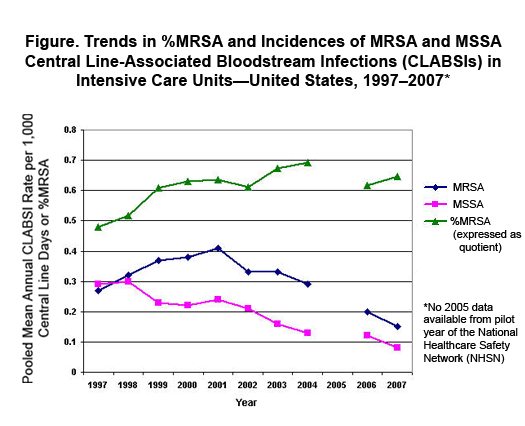Abstract for SHEA 18th Annual Scientific Meeting Late Breaker
Comparison of Measures of MRSA Related to Central Line-Associated Bloodstream Infections in Intensive Care Units—United States, 1997–2007
Deron C. Burton1, Jonathan R. Edwards1, Scott K. Fridkin11Centers for Disease Control and Prevention, Atlanta, GA
Background. In recent years, surveillance data have shown increasing percent oxacillin/methicillin resistance among Staphylococcus aureus isolates (%MRSA) from intensive care unit (ICU) patients with hospital-associated infections. Since Fall 2007, legislative mandates regarding MRSA prevention have been prompted, in part, by interpretations of rising %MRSA as indicating a failure of current prevention programs. However, translating %MRSA to disease burden is not well understood.
Objective. We sought to determine whether increasing %MRSA in central line-associated bloodstream infections (CLABSIs) caused by S. aureus reflects an increasing rate of MRSA CLABSIs among ICUs reporting data during the most recent 10 years of national surveillance conducted by the Centers for Disease Control and Prevention (CDC).
Methods. Data were reported through CDC's National Nosocomial Infections Surveillance (NNIS) System from 1997-2004 and through CDC's National Healthcare Safety Network (NHSN) from 2006-2007. In both systems during the months and ICUs selected for surveillance, infection control professionals used standard methods and definitions to identify and report all central line days and CLABSIs attributed to the ICU stay; when available, antibiotic susceptibility data also were reported. Data from all facilities were aggregated to calculate pooled mean annual CLABSI rates per 1,000 central line days for MRSA and methicillin-susceptible S. aureus (MSSA) across major ICU types (including medical, medical/surgical, surgical, pediatric, coronary, and cardiothoracic). Pooled mean %MRSA was calculated over all units by year. Reported P-values were obtained by Chi-square tests.
Results. Overall, 4,076 S. aureus CLABSIs (with susceptibility data) were reported from 1,679 ICUs representing 8,575,848 central line days of surveillance. Over the study period, %MRSA for S. aureus isolates rose from 47.9 in 1997 to 64.7 in 2007, representing a relative 35.1% (P<0.0001) increase (Figure). However, although MRSA CLABSI incidence appeared to increase between 1997 and 2001, it steadily declined over the remaining study period, resulting in an overall 44.4% (P<0.0001) reduction in incidence. MSSA CLABSI incidence also declined over the study period, for an overall 72.4% (P<0.0001) reduction in incidence.
Conclusion. The discordance between trends in %MRSA and MRSA incidence of CLABSIs reported over the past decade of national ICU surveillance demonstrates a limitation of using %MRSA to monitor changes in the burden of MRSA hospital-associated infections.

The chart above shows trends in MRSA incidence rate, MSSA incidence rate, and %MRSA for central line-associated bloodstream infections (or CLABSIs) in intensive care units (ICUs) that were reported to CDC from 1997 to 2007. No data are available from the pilot year (2005) of the National Healthcare Safety Network (NHSN).
The y-axis ranges from 0 to 0.8 in 0.1-unit increments and represents, alternatively, the pooled mean CLABSI incidence rate per 1,000 central line days, or the %MRSA (expressed as a fraction). The x-axis runs from the year 1997 to the year 2007 in 1-year increments.
There are 3 separate lines plotted on the figure:
- The first line represents %MRSA and shows that %MRSA increased from 48% in 1997 to 65% in 2007.
- The second line represents the pooled mean annual incidence rate of MRSA CLABSIs and shows that MRSA incidence increased from 0.27 per 1,000 central line days in 1997 to 0.41 in 2001, and then decreased to 0.15 in 2007.
- The third line represents the pooled mean annual incidence rate of MSSA CLABSIs and shows that MSSA incidence decreased from 0.29 per 1,000 central line days in 1997 to 0.08 in 2007.
Thus, the above chart demonstrates that there is discordance in the direction of change of %MRSA (increasing) compared to MRSA incidence (overall decreasing) over the analysis period.
Content source:
Division of Healthcare Quality Promotion (DHQP)
National Center for Preparedness, Detection, and Control of Infectious Diseases
